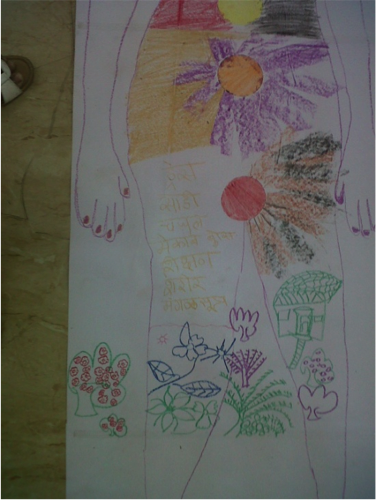
The rabbit and the monster is a story about a baby rabbit all alone in a jungle trying to escape a terrifying monster. This rabbit could have been eaten but in this story our rabbit is spiritually connected to a divine energy. Empowered by this energy…
… a young woman, 19 years old, takes a toy gun, a belt, a knife, a stick and just about any weapon-like thing that is given to her and destroys the face of a monster created with paint and newspaper on a pillow. There are two others in this room, observing this catharsis, watching the destruction of face on pillow and then the destruction of the pillow. Clouds of pillow belly cotton fill the air as …
… the enraged but empowered rabbit destroys the monster and the 19 year old woman dances on the shredded shreds of a pillow, whipping, beating, shooting and stabbing it.
The woman returns to her husband and family. We will call her Pinnari.
A few months ago Pinnari had been referred by her clinical psychologist to Kavita Pillai, a qualified practitioner of Arts Based Therapy (ABT), and an Assistant Director and Board Member at the Bapu Trust for Research on Mind and Discourse. At the time of this transfer, the psychologist who had been working with the 19-year-old for seven months felt uncomfortable because the client was not responding to psychological intervention. Her case notes had a list of diagnostic assessment points that included borderline personality disorder, behavioural disorder, anger and anxiety. Preoccupation with sex and body was the last thing in a long list of assessment points.
According to Kavita, Pinnari appeared to be a person with severe mental disorder (SMD), psychotic, delusional, incoherent, with no sense of self, low functioning and all over the place. She had been raped at the age of nine by the man she later married and continued to be married to and she had been sexually abused by other members of the family. She faced sexual abuse even at the time that she was in therapy. She had no sense of self or body apart from her sexual self. Her obsession with sex was such that she spoke of it and of her sexual self all the time. It was this that her clinical psychologist found difficult to deal with and so she ignored it when she was not feeling uncomfortable and outraged by it herself. This was due greatly to the obvious effect of her Brahmanical, upper caste sense of morality judging a lower caste woman preoccupied with sex. This perspective coloured her approach to psychological intervention. Pathological labelling of Pinnari left no space for understanding the impact of childhood and continuing trauma caused by sexual abuse.
Kavita, herself unprepared for the enormous trauma trapped inside her client, wondered how she was going to engage her in therapy. How was she going to speak to her? Between her and Bhargavi Davar, founder of Bapu Trust*, there were many brainstorming sessions. Kavita used many body healing techniques including dynamic meditation, chakra healing techniques and ABT tools such as body mapping, Mandala drawings, storytelling, dancing, drumming. The importance of working with multiple techniques such as these must be underlined. As Bhargavi recalls, lots of subtle work was done with lifting the energies from the sex chakra towards the crown chakra. These tools were used to draw out the anger, fear and grief trapped inside the 19-year-old.
When sexuality and mental health are spoken of you rarely get – ‘A happy sense of sexuality contributes to positive, powerful mental health’. The two concepts do not often meet. However, ask a sexologist about the mental health of clients and you may hear a lot. Some of it is funny and some of it is sad. A look at Dr. Mahinder Watsa’s Sexpert column for today yielded this gem:
The humour in it contributes to my mental health. But now – here’s some more from a BBC interview of the doctor. In this interview he speaks of a time decades ago when he began his work, “For the first few months the questions were of a general medical nature – about childhood diseases and so on – but then a different kind of letter began to arrive, from distressed young women in remote areas.” They told him that an uncle or an elder had interfered with them when they were teenagers, and now they worried that they would not be married because they’d lost their virginity. “Many even suggested that they’d commit suicide,” says Watsa.” Decades later, times haven’t changed.
He’s 10. He has temper tantrums. Peed from the second floor bathroom window onto a teacher’s head.
She’s 12. She doesn’t listen to anyone, tears her homework copybook and yells back at her mother. The whisky in the bottle inside the bar cupboard is tasting watered down. Who could it be?
He’s 13. He ran away from school, spent a day and a night hiding in a crowded marketplace, came back home and got a good thrashing. (‘good thrashing?’). He went to his room, took out his blade and cut his palm in neat bloody parallel lines.
Now one of these kids is 30 years old.
A young and earnest therapist who works with children is sitting at her desk waiting for her next client. She has a cheerful workspace, surrounded with children’s crayon drawings and a couple of love letters to her written by seven and nine year olds who adore her. She is doing a favour for a colleague and has given time to this next client who is an adult woman about 30 years old. They’ve never met before. The bell rings. The client arrives. The next 45 minutes are excruciatingly painful for the young and earnest. The client introduces herself and her issues in an articulate and thoroughly processed way. She is clear about the help she needs, the rage she feels, the panic disorder she is trying to deal with. The problem is, the therapist doesn’t know how to deal with any of it because it’s all about sex and sexuality. When the session is over, both know there will never be a repeat. The client goes out laughing at the obvious effect she’s had on the expert. The expert stares at the crayon drawings and feels relieved that it’s over and she can return to the nine year olds who adore her. The only big problems she deals with are temper tantrums, lack of concentration, poor results in school. Behavioural disorders. ADHD, CD, ODD. No sex, she thinks, no sexuality, none of that. This is the approach she carries forward into her therapy engagements with children and young people.
The strong connection between sexuality and mental health is missed by most people, including experts in mental health. Perhaps people working on sexuality have already tripped and jumped over the stigma barrier, the repression and morality barrier, the other obstacles in the course. They are using the alphabets S-E-X all the time and connecting it to all parts of the human’s being. Then you have people working in mental health. They’ve dealt with similar barriers, stigma, being the most prominent, by taking the safe, medical, theoretical, intellectual approach. They are doing good, helping people. However, which is the more difficult subject to talk about? Mental health or sexuality? I may be wrong but I think that many people in mental health think that they can afford to ignore sexuality because it makes them uncomfortable and sometimes it makes them angry too. It is enough that they are handling rage, panic and psychosis. Roots in chemical imbalance, that’s what the textbooks said. Most people in sexuality know that sexuality issues are already affecting the mental health and daily lives of the people who come to them. It is time many more people, experts and the rest of us plodders, made this connect.
It is very difficult to find references to studies and experiences that have attempted to coherently connect sexuality and mental health. The great danger in disconnecting mental health issues from sexuality issues lies in mis-diagnosis, invisibilising and dismissing the life experiences of a human being. Take the matter of sexual orientation and gender identity. How do the experiences of people wrestling with these issues affect their mental health?
The rabbit and monster story? Pinnari stopped therapy herself some months after the monster was vanquished. She stopped the sexual abuse from family members but she decided to return to her husband. The right and wrong of her decisions may be up for debate, but the decision was hers and she made it after addressing the root cause of her particular distress and repairing her fragmented sense of self. Arts Based Therapy provided a safe space to make the connect between sexuality and mental health, a place where a young woman could give vent to the rage and grief that had been trapped along with continuing childhood trauma in her system.
*The Bapu Trust for Research on Mind and Discourse is a national organization, working locally in Pune city to create innovative Urban Community Mental Health Programs (UCMH). The purpose of the UCMH program is to create emotionally sustainable communities. The organisation works towards enhancing and promoting the emotional well being of persons in vulnerable positions (women, poor, children) and other communities in need. Their strategy is to create innovative preventive programs in the community, so that the psychological burden in the community is shared, and in doing so, is reduced.
